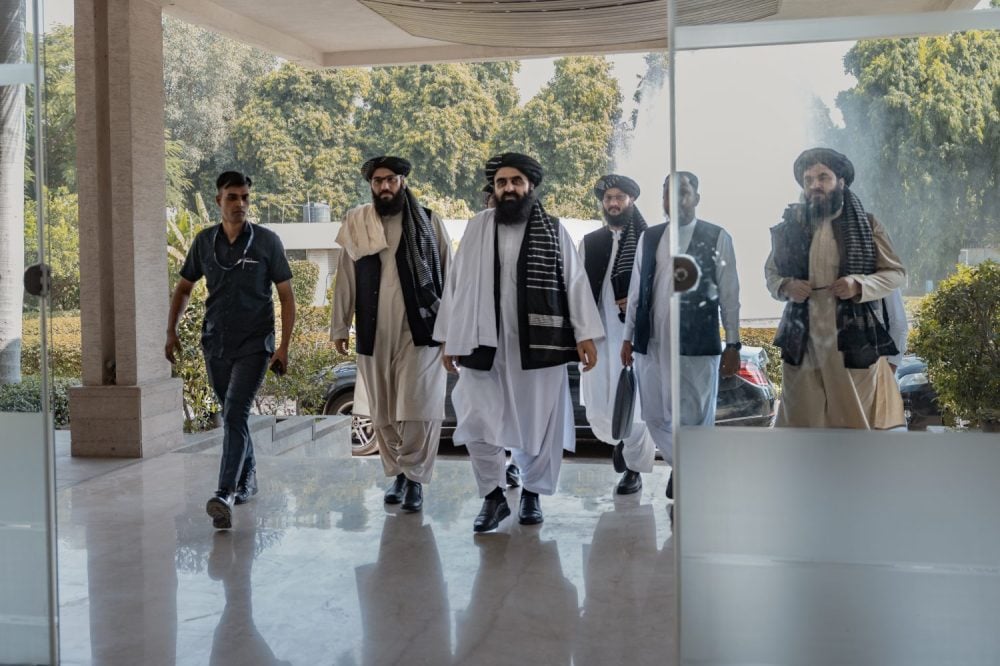If geography is destiny, then nowhere is this equation more relentless than at the subcontinent’s northwestern frontier. Since the partition of British India in 1947, two patterns have held steady: hostility between Afghanistan and Pakistan, and warmth between Afghanistan and India. No matter who rules in Kabul—monarchists, communists, or various iterations of Islamists—the pattern endures. Pakistan helped create and nurture the Taliban to end these patterns once and for all; today, the Taliban are battling Pakistan and looking to India for balance.
Renewed clashes along the Pakistan-Afghanistan border in October fit perfectly within this historical rhythm. The irony is unmistakable: The same Pakistan that helped install the Taliban in power finds itself locked in an escalating conflict with them—and negotiating only through third parties.
Amid the border tensions with Pakistan, Afghan Foreign Minister Amir Khan Muttaqi traveled to India for a weeklong visit in October and reaffirmed Kabul’s interest in strong ties with New Delhi. India, which once declared there was no such thing as a good Taliban and denounced the group as a strategic asset of Pakistan, could not hide its glee. Within days of the visit, New Delhi upgraded its technical mission in Kabul to a full-fledged embassy and became one of the first countries to normalize ties with Taliban-ruled Afghanistan.
It did not require extraordinary diplomatic exertion to bring the two closer. Most of the heavy lifting was done by the logic of history and geography in the frontier. The natural alignment between Kabul and New Delhi is once again asserting itself, only with new actors.
The triangular dynamic between the three countries is as old as Pakistan itself. Every Afghan regime, regardless of ideology, has sooner or later clashed with Pakistan. One structural problem between Afghanistan and Pakistan is the Durand Line—the 1893 border agreement between British India and the emir of the Emirate of Afghanistan, Abdur Rahman Khan, that cut across Pashtun and Baloch lands. When newly created Pakistan inherited this colonial line in 1947, Afghanistan was the only country to vote against Pakistan’s admission to the United Nations because it refused to recognize the Durand Line as a legitimate frontier.
It was one thing to accept a border imposed by the British Empire, but it was quite another to accept it from what Kabul viewed as the “rump state” of the Raj. Successive governments in Afghanistan toyed with the idea of a Pashtunistan state that united Pashtuns on both sides of the line—an irredentist nightmare for Islamabad that persists to this day.
Pakistan does not view its border problem with Afghanistan as merely cartographic but existential. The fear of a two-front situation against both India and Afghanistan created extreme anxiety in Pakistan’s security establishment.
The Pakistani army inherited the geopolitical idea of strategic depth from the Raj. Like the British, Pakistan wanted Afghanistan to be a buffer state run by a friendly and pliable regime. From the 1950s onward, Pakistani rulers from Ayub Khan to Muhmmad Zia-ul-Haq tried to shape Kabul’s politics by supporting tribal militias and Islamist proxies. Every attempt backfired.
By the late 1970s, Islamabad found a new instrument: jihadist militancy. The Soviet invasion of Afghanistan in 1979 and the ensuing U.S.-Saudi-Pakistani proxy war against Moscow gave Islamabad unprecedented leverage. If Washington wanted to bleed the Soviet bear in Afghanistan, Islamabad wanted to kill the ethnic conception of a Pasthtunistan state with an Afghan identity.
When the Soviet-backed Najibullah regime finally fell in 1992, Pakistan-trained Afghan mujahideen took over. But the new Islamist rulers, who had previously denounced India’s support to the pro-Soviet regime, now turned to New Delhi to balance against Islamabad’s meddling in Kabul’s affairs.
As the mujahideen splintered and turned on each other at home, Pakistan promoted the Taliban in the early 1990s to restore order. By 1996, they had captured Kabul, seemingly delivering Islamabad its long-sought strategic depth.
Yet even at the height of Pakistani patronage, the Taliban never truly submitted. They signaled independence and an openness to a positive relationship with India. If Pakistan had hoped that the Islamists—whether of the mujahideen or the Taliban variety—would abandon their Pashtunistan claims and accept the Durand Line, then it was disappointed.
Since returning to power in 2021, the Taliban have been determined to assert Afghan sovereignty. Relations with Pakistan have deteriorated rapidly. Cross-border attacks, Pakistan’s construction of a border fence on the Durand Line, and Islamabad’s charge that Kabul shelters the Tehrik-i-Taliban Pakistan (an extremist group also known as the Pakistani Taliban) have pushed the two sides into open confrontation. The Taliban also resent Islamabad’s expulsion of Afghan refugees and its attempts to dictate terms.
Against this backdrop, the Taliban’s outreach to India was no surprise. India’s reengagement with Kabul since 2021 has been cautious, pragmatic, and deliberately quiet. It restored humanitarian aid and signaled openness to engagement as long as the Taliban promised not to let their country be used as a refuge and staging ground for anti-India terrorists.
The Taliban were happy to offer this, and India was eager to support Afghanistan’s sovereignty and territorial integrity. With Pakistan controlling Afghanistan’s access to the Indian Ocean and potential overland routes to India, New Delhi has sought to help by developing alternative routes through Iran and building an India-Afghanistan air bridge to promote commerce.
One of the significant elements of Muttaqi’s trip to India was his visit to an Islamic seminary in Deoband, a town in Uttar Pradesh that’s not far from New Delhi. Darul Uloom Deoband, one of the most influential centers of Islamic learning, has shaped Islamic thought throughout South Asia. The Deobandi school of Islam was foundational to the Taliban’s ideology before morphing into a more virulent form in Pakistan and Afghanistan.
During his visit, Muttaqi received a Hadith teaching certificate and the right to use the “Qasmi” title. This was a major break for the Taliban, whose clerical cadre was trained in Pakistan, especially Darul Uloom Haqqania in Akora Khattak. In reconnecting with Deoband, Muttaqi was also signaling the Taliban’s religious autonomy from Pakistan.
India’s improved political fortunes in Kabul does not, however, signify a serious rivalry with Pakistan over Afghanistan. India’s lack of a border with Afghanistan means that New Delhi can never really compete with Islamabad, which has nearly 1,600 miles of shared frontier. Pakistan’s intelligence agencies have been deeply involved in the Afghan wars over the last five decades.
But India does not have to compete with Pakistan in Afghanistan. Its natural alignment with Afghanistan rests on patience, a bit of developmental assistance, and respect for Afghan sovereignty. Afghanistan is Pakistan’s to lose, and India does not need to do too much to keep Kabul on its side.
Pakistan’s tragedy is easy to see. It is the most important external actor in Afghanistan and has the power to disrupt any regime there. But unlike the British Raj, it does not have the resources to build a lasting and friendly edifice in Kabul. Pakistan’s search for hegemony over Afghanistan will remain elusive, but it is unlikely to give up. Pakistan may well try to split the Taliban in the pursuit of a regime change in Kabul. But no matter what Pakistan does, and whether or not it succeeds, it cannot change the logic of geopolitics on the Afghan frontier.
The post The Taliban’s Entry Into India-Pakistan Rivalry appeared first on Foreign Policy.




